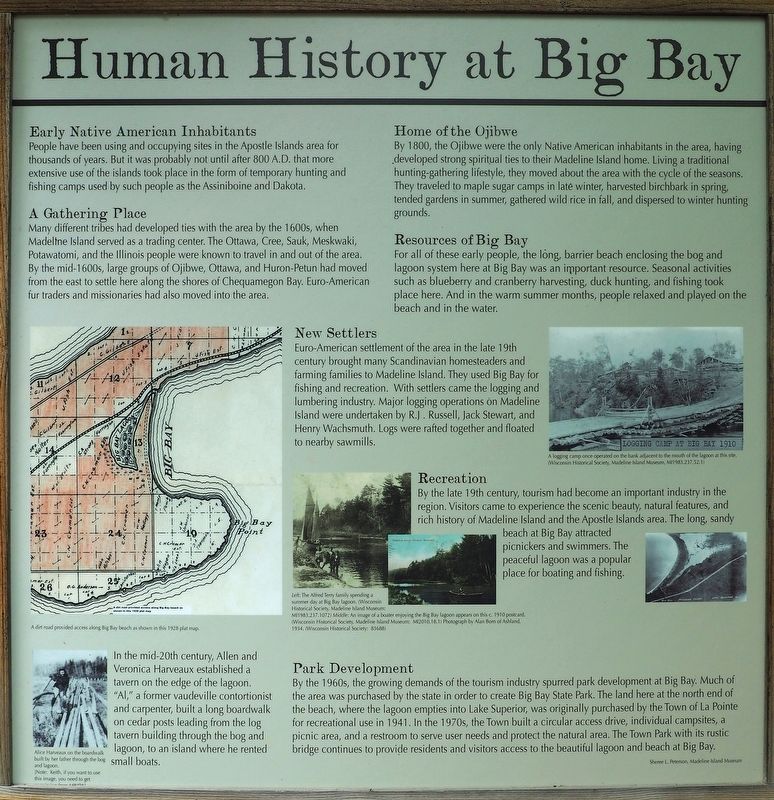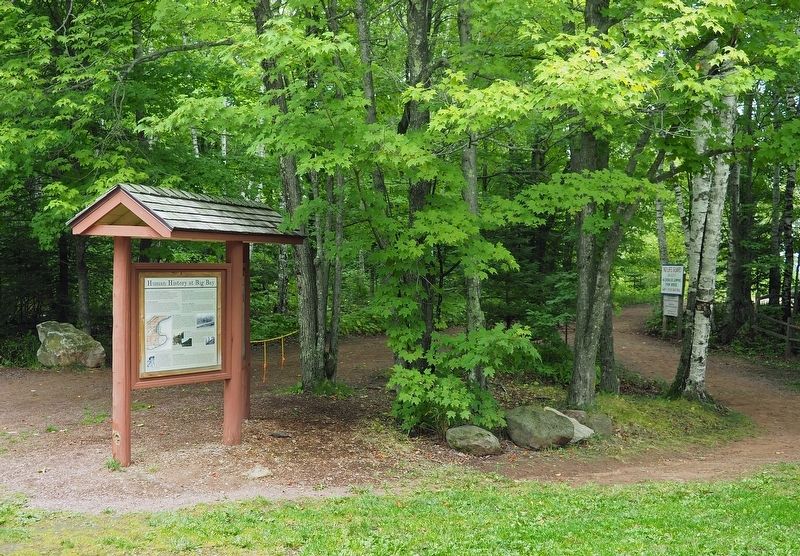Near La Pointe in Ashland County, Wisconsin — The American Midwest (Great Lakes)
Human History at Big Bay
People have been using and occupying sites in the Apostle Islands area for thousands of years. But it was probably not until after 800 A.D. that more extensive use of the islands took place in the form of temporary hunting and fishing camps by such people as the Assiniboine and Dakota.
A Gathering Place
Many different tribes had developed ties with the area by the 1600s, when Madeline Island served as a trading center. The Ottawa, Cree, Sauk, Meskwaki, Potawatomi, and the Illinois people were known to travel in and out of the area. By the mid-1600s, large groups of Ojibwe, Ottawa, and Huron-Petun had moved from the east to settle here along the shores of Chequamegon Bay. Euro-American fur traders and missionaries had also moved into the area.
Home of the Ojibwe
By 1800, the Ojibwe were the only Native American inhabitants in the area, having developed strong spiritual ties to their Madeline Island home. Living a traditional hunting-gathering lifestyle, they moved about the area with the cycle of the seasons. They traveled to maple sugar camps in late winter, harvested birchbark in spring, tended gardens in summer, gathered wild rice in fall, and dispersed to winter hunting grounds.
Resources of Big Bay
For all of these early people, the long, barrier beach enclosing the bog and lagoon system here at Big Bay was an important resource. Seasonal activities such as blueberry and cranberry harvesting, duck hunting, and fishing took place here. An in the warm summer months, people relaxed and played on the beach and in the water.
New Settlers
Euro-American settlement of the area in the late 19th century brought many Scandinavian homesteaders and farming families to Madeline Island. They used Big Bay for fishing and recreation. With settlers came the logging and lumbering industry. Major logging operations on Madeline Island were undertaken by R.J. Russell, Jack Stewart, and Henry Wachsmuth. Logs were rafted together and floated to nearby sawmills.
Recreation
By the late 19th century, tourism had become an important industry in the region. Visitors came to experience the scenic beauty, natural features, and rich history of Madeline Island and the Apostle Islands area. The long, sandy beach at Big Bay attracted picnickers and swimmers. The peaceful lagoon was a popular place for boating and fishing.
In the mid-20th century, Allen and Veronica Harveaux established a tavern on the edge of the lagoon. "Al," a former vaudeville contortionist and carpenter, built a long boardwalk on cedar posts leading from the log tavern
building through the bog and lagoon, to an island were he rented small boats.
Park Development
By the 1960s, the growing demands of the tourism industry spurred park development at Big Bay. Much of the area was purchased by the state in order to create Big Bay State Park. The land here at the north end of the beach, where the lagoon empties into Lake Superior, was originally purchased by the Town of La Pointe for recreational use in 1941. In the 1970s, the Town built a circular access drive, individual campsites, a picnic area, and a restroom to serve user needs and protect the natural area. The Town Park with its rustic bridge continues to provide residents and visitors access to the beautiful lagoon and beach at Big Bay.
Topics. This historical marker is listed in these topic lists: Native Americans • Parks & Recreational Areas • Settlements & Settlers.
Location. 46° 49.181′ N, 90° 40.569′ W. Marker is near La Pointe, Wisconsin, in Ashland County. Marker is on Town Park Circle east of Big Bay Road. Located in Big Bay Town Park at the east end of the parking lot. Touch for map. Marker is at or near this postal address: 2305 Town Park Cir, La Pointe WI 54860, United States of America. Touch for directions.
Other nearby markers. At least 8 other markers are within 7 miles of this marker, measured as the crow flies. Gidanamikaagoo omaa Mooningwanekaaning (within shouting distance of this marker); Early Vessels (approx. 5.9 miles away); Mooningwaanikaaning (approx. 6 miles away); La Pointe Indian Cemetery (approx. 6 miles away); The Booth Cooperage (approx. 6˝ miles away); Memorial to Commercial Fishermen of Bayfield (approx. 6˝ miles away); Bayfield Historic Waterfront (approx. 6˝ miles away); A Turning Point in Place and Time (approx. 6.6 miles away). Touch for a list and map of all markers in La Pointe.
Credits. This page was last revised on January 27, 2021. It was originally submitted on January 26, 2021, by McGhiever of Minneapolis, Minnesota. This page has been viewed 265 times since then and 31 times this year. Photos: 1, 2. submitted on January 26, 2021, by McGhiever of Minneapolis, Minnesota. • Mark Hilton was the editor who published this page.

